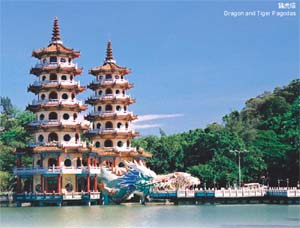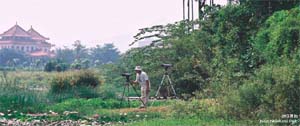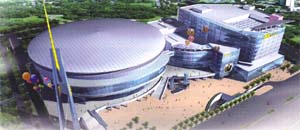Zuoying──Where the Past Meets the Present / 左營現代與懷舊
◎Written by Ya-xiang Wang ◎Photographs by Ya-xiang Wang and Jung-Hui Pao
 Zuoying was Kaohsiung's political and educational center when Kaohsiung first came into existence. As a result, tourists can easily find historic sites of Ming and Ching dynasties here. In the Ching Dynasty, the government built four gates in order to expand Zuoying as well as and a moat around the city. Zuoying thus became the first walled city in Taiwan. Facing the sea with a backdrop of Gueishan (the mountain of the Turtle), Sheshan (the mountain of Snakes), Chaisan and the Banpingshan Park, Zuoying has always been an essential military hub to the city. After World War II, Zuoying became a military harbor. Even now, the Navy still stations itself there. Therefore, due to such glorious history, traditional architecture, historical sites, military culture and its beautiful natural surroundings, Zuoying can be seen to provide many special features.
Zuoying was Kaohsiung's political and educational center when Kaohsiung first came into existence. As a result, tourists can easily find historic sites of Ming and Ching dynasties here. In the Ching Dynasty, the government built four gates in order to expand Zuoying as well as and a moat around the city. Zuoying thus became the first walled city in Taiwan. Facing the sea with a backdrop of Gueishan (the mountain of the Turtle), Sheshan (the mountain of Snakes), Chaisan and the Banpingshan Park, Zuoying has always been an essential military hub to the city. After World War II, Zuoying became a military harbor. Even now, the Navy still stations itself there. Therefore, due to such glorious history, traditional architecture, historical sites, military culture and its beautiful natural surroundings, Zuoying can be seen to provide many special features.
The Intermodal Transfer Station for the railway, the MRT (Mass Rapid Transit System), and the HSR (High Speed Rail) will all be based in Zuoying, which will it a hub of transportation in Kaohsiung. Zuoying not only has an honored past but also a bright future as well.
An Ancient City with Cultural Resources
Zuoying has been a military center since ancient times. In 1722, the walled city's four gates were built, known as the East, South, West and North gates. Today, out of the three remaining gates, the East and North gates attract many tourists due to their perfect preservation. It is worth noting that, on each side of North gate, two "door gods" have been embedded which are considered to be the largest clay door god sculptures in existence.
The remarkable history of Zuoying is also visible in the diversity of people's religious beliefs. There are many temples, each worshiping different gods, around the Lotus Lake area, thus providing all residents with a chance to seek inner peace.
Prominent Sites
The Confucius Temple in Zuoying is the largest one in Taiwan. Its layout and structure represent different meanings. The tall wall standing in front of the temple signifies how great Confucius' wisdom is. To walk down through the Gate of Rites and along the Path of Righteousness means to follow Confucius' philosophy. Embellished with golden glass tiles and animal figures, the rooftop of the temple conveys Confucius' precept of educating all without discrimination; even animals could become Confucius' students if they wanted to.
Built in 1976, the Dragon and Tiger Pagodas are two seven-story brightly-colored buildings. While visiting, tourists have to enter the two towers via the dragon and exit from the tiger in order to gain good luck.
Right next to the Dragon and Tiger Pagodas are the well-known Spring and Autumn Pavilions, which were rebuilt in 1951. The two pavilions are connected by a corridor with a Bodhisattva Kuanyin statue standing at the front. Beautiful scenery is everywhere around the Spring and Autumn Pavilions. Tourists often stand on the corridor gazing at the ripples and reflections on the water.
In addition to the gorgeous temples, the Zuoying Historic Path provides visitors a chance to see all the historical sites at the same time. Starting from Dianzaiding Rd. and ending at Zuoying Sia Rd., the 263-meter path will take you through some of the most traditional alleyways and buildings.
The Famous Lotus Lake
 The Lotus Lake in Zuoying is famous in Taiwan as well as in other countries. It was named in the Ching Dynasty after the flourishing lotus and water caltrop growing in the lake.
The Lotus Lake in Zuoying is famous in Taiwan as well as in other countries. It was named in the Ching Dynasty after the flourishing lotus and water caltrop growing in the lake.
In recent years, the Kaohsiung City Government built the bicycle path around Lotus Lake so that the citizens would be able to ride around the lake and enjoy its spacious views.
Lotus Lake used to be a huge basin surrounded by a lotus and water caltrop field, causing it to become the habitat of pheasant-tailed jacanas. Kaohsiung City government and Wetlands Taiwan took part in setting up the Jhouzih Wetland Park in the hope of restoring the habitat for jacanas and other wild animals. They successfully launched the "Welcome Jacanas Home Project" to restore the rich ecological diversity in the area which has given people a serene place to recall the past.
Visitors can also climb along the trail to the Banpingshan Nature Park, which is located on the north side of Lotus Lake, in order to view the Lotus Lake and Gueishan in their entirety.
A Unique Culture
Between 1945 and 1949, a group of new immigrants from China followed the military and moved to Taiwan. Later, the Department of Defense set up a navy base here and built military villages in Zuoying for families of the Navy. Consequently, Zuoying has become the largest home base for military villages. What is worth mentioning is that most people who have lived in or near military villages, often originate from a Naval related background.
The military villages forms the basis of the society; residents from various provinces of China brought in different ways of living, as well as their food and varying cultures.
Kaohsiung Arena
The Kaohsiung Arena, covering nearly 56,200 square meters, is to reach completion in Zuoying, at the junction of Boai Road and the Xinzhuangzai Road by the end of December, 2007. By that time, Kaohsiung citizens will have a 15,000-seat multi-functional stadium where they can go for exercise, recreation and shopping.
◎文/王雅湘
◎攝影/王雅湘.鮑忠暉
左營是高雄市最早發展的政教中心,在這裡,明清遺跡隨處可尋,清朝時左營擴建為石城,闢有四個城門,城門外有護城壕,是台灣城池之祖。由於地理位置面海,背臨龜山、蛇山、柴山、半屏山等,所以不僅在古代視為軍事重鎮,從二次大戰後也發展為軍港,現在海軍仍駐紮於此,因此,傳統建築、台灣舊聚落、眷村文化以及自然風光交織成左營豐富的人文與景觀。
而高雄的三鐵(台鐵、捷運、高鐵)車站共構目前也先落腳於左營,未來左營更成為交通運輸的轉運站。左營不但散發歷史氣息,更將展現無限的動能。
人文薈萃的古城
左營自古即為軍事重鎮,清朝康熙61年(西元1722
年)造土城,建東、南、西、北四門,目前僅存三座城門,外觀宛如碉堡一般。而東門與北門因保存的完整性,常為遊客駐足;值得一提的是,北門兩側各嵌有一尊門神,是全台面積最大的泥塑門神。
左營開發得早,民間信仰在此呈現多元風貌,蓮池潭附近有許多寺廟,供奉的神明種類眾多,都是人們的精神寄託,更是民間藝術最活躍的展現。
著名景點
左營孔廟的面積為全台最大,其建築格局極富教育意涵,孔廟前的高牆「萬仞宮牆」,喻含讚美孔子道德學問的高深,孔廟內的禮門與義路表示追求孔子之道,孔廟屋頂採金黃色琉璃瓦,屋脊上有飛禽走獸,代表孔子「有教無類」,連飛禽走獸都樂於從四處前來聽道。
建於西元1976年龍虎塔,塔高七層,採黃牆、紅柱、橘瓦的鮮明色彩。遊客遊歷龍禪、虎禪兩塔必需「入龍喉出虎口」,有逢兇化吉之意。
緊臨龍虎塔是聞名全台的春秋閣,為西元1951年新建,兩塔間有一個迴廊,裝飾有騎龍觀音菩薩,春秋閣處處是風景,從橋上可欣賞湖面的波光粼粼。
除了廟宇在建築內涵上精采的呈現,蓮池潭畔的「左營下路歷史景觀步道」是左營傳統聚落的精華,位於舊城國小旁,北起店仔頂路,南至左營下路,長263公尺的舊部落內巷道及傳統民宅,完整保存台灣鄉土建築。
遠近馳名的蓮池潭
左營的蓮池潭可說是馳名中外,清朝時期潭內蓮花、菱角盛產一時,因此命名。
近年來,蓮池潭的週邊鋪設了木棧道,此外,民眾也可悠閒地騎著腳踏車沿著環潭自行車道欣賞左營的好山好水。
蓮池潭過去是一個大型蓄水埤塘,週邊遍佈菱角田,一度成為水雉的最大聚集地。在高雄市府與台灣濕地保護聯盟的共同規劃下,在都會區裡營造以野生動物棲息為主的洲仔濕地公園,並成功進行「水雉返鄉計畫」,豐富的生態樣貌,讓民眾回到60年代寧靜的埤塘風光。
而位於蓮池潭北邊的半屏山自然公園,沿木棧道登山可順著稜線到達200多公尺的高點,眺望蓮池潭與龜山。
別樹一幟的眷村文化
1945到1949年,台灣湧進了一波來自大陸各省的新移民,隨著部隊來到台灣各地,而左營區自從國防部海軍基地成立後,部份軍區內的空地也陸續建了眷村,更搖身一變成為高雄眷村的大本營,值得一提的事,落腳於左營眷村的人整體而言具有海軍背景的專業。
眷村儼然是一個小社會,眷村的住戶帶來各省迥異的生活型式,呈現各省文化及飲食文化的面貌。
 高雄巨蛋
高雄巨蛋
高雄大型的運動場地─巨蛋也落腳在左營,位於博愛路與新庄仔路的交叉口,面積為1萬7千多坪,集健康、休憩、購物三合一的綜合體育館。巨蛋預計於2007年12月底完工,屆時本市將擁有一座設置1萬5千席的多功能體育館。